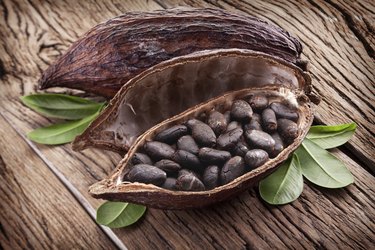
Raw cacao powder is the basic, most important ingredient for making chocolate, whether it is dark, milk or white chocolate. While chocolate may have numerous health benefits for you depending on the type you eat, it should still be eaten sparingly because it can be high in added fat and sugar. Raw cacao powder can be used in place of chocolate in drinks as well as baked goods, adding a rich taste and the nutritious benefits of chocolate with less sugar and fat.
What Cacao Is
Video of the Day
Raw cacao powder is the same as raw cocoa powder -- cacao and cocoa are used interchangeably to refer to the basic powder made from whole, roasted cacao beans that have been ground up. Raw cacao refers to the cacao beans and tree that provide the pods used to make chocolate. It has undergone minimal processing, but much of the natural fat found in cacao beans, the cocoa butter, is removed, so the powder is relatively low in fat. But the term "cocoa" also sometimes refers to the powder used to make hot chocolate, which is different from raw cacao because it contains added sugar, fat and milk products.
Video of the Day
Health Benefits
A 2011 issue of "Antioxidants & Redox Signaling" published a review on the health benefits of cocoa and chocolate and found that the flavonoid content of chocolate helped to protect nerves from damage, as well as providing a boost to the immune system and reducing oxidative damage as a result of exposure to ultraviolet rays. In 2014, the "European Journal of Nutrition" published an animal study that found taking cocoa powder as a supplement led to less inflammation, including when it was taken as part of a high-fat diet. Researchers in the study concluded that cocoa powder could help reduce the risk of obesity and fatty liver disease.
Nutritional Profile
A 1-tablespoon serving of cacao powder has only 12 calories, a little more than 1 gram of fat, a minimal amount of sugar and 1.8 grams of dietary fiber. A single serving also contains 12 milligrams of caffeine. A serving of cacao powder is not a good source of minerals or vitamins, although it contains small amounts of calcium, iron, magnesium and phosphorous, as well as members of the vitamin B complex, including thiamine, riboflavin, niacin vitamin B-6 and folate. It also contains small amounts of vitamin E and K. Cacao powder is not usually eaten on its own, so the nutritional value of foods containing cacao powder will be affected more by the other ingredients used. For example, with a smoothie, the type of fruit and yogurt content will have a greater effect on overall nutrition than the tablespoon serving of cacao powder.
Using Cacao
Cacao powder can be added to a variety of baked goods. You can also mix in a tablespoon or two of raw cacao with juices or smoothies, or try sprinkling it on top of frozen yogurt for a healthy way to add chocolate flavor. Raw cacao powder must have undergone minimal processing, so do not use Dutch-process cocoa, which can often be found in grocery stores. This cocoa has been treated with a chemical solution to make the taste of cocoa powder milder and to giver it a darker color.
- National Confectioners Association: How Chocolate Is Made
- BBC Food: Cocoa Powder Recipes
- Cleveland Clinic: Heart Health Benefits of Chocolate
- USDA National Nutrient Database: Cocoa, Dry Powder, Unsweetened
- Antioxidants & Redox Signaling: Cocoa and Chocolate in Human Health and Disease
- European Journal of Nutrition: Dietary Cocoa Ameliorates Obesity-Related Inflammation in High Fat-Fed Mice
- David Leibovitz: Cocoa Powder FAQ